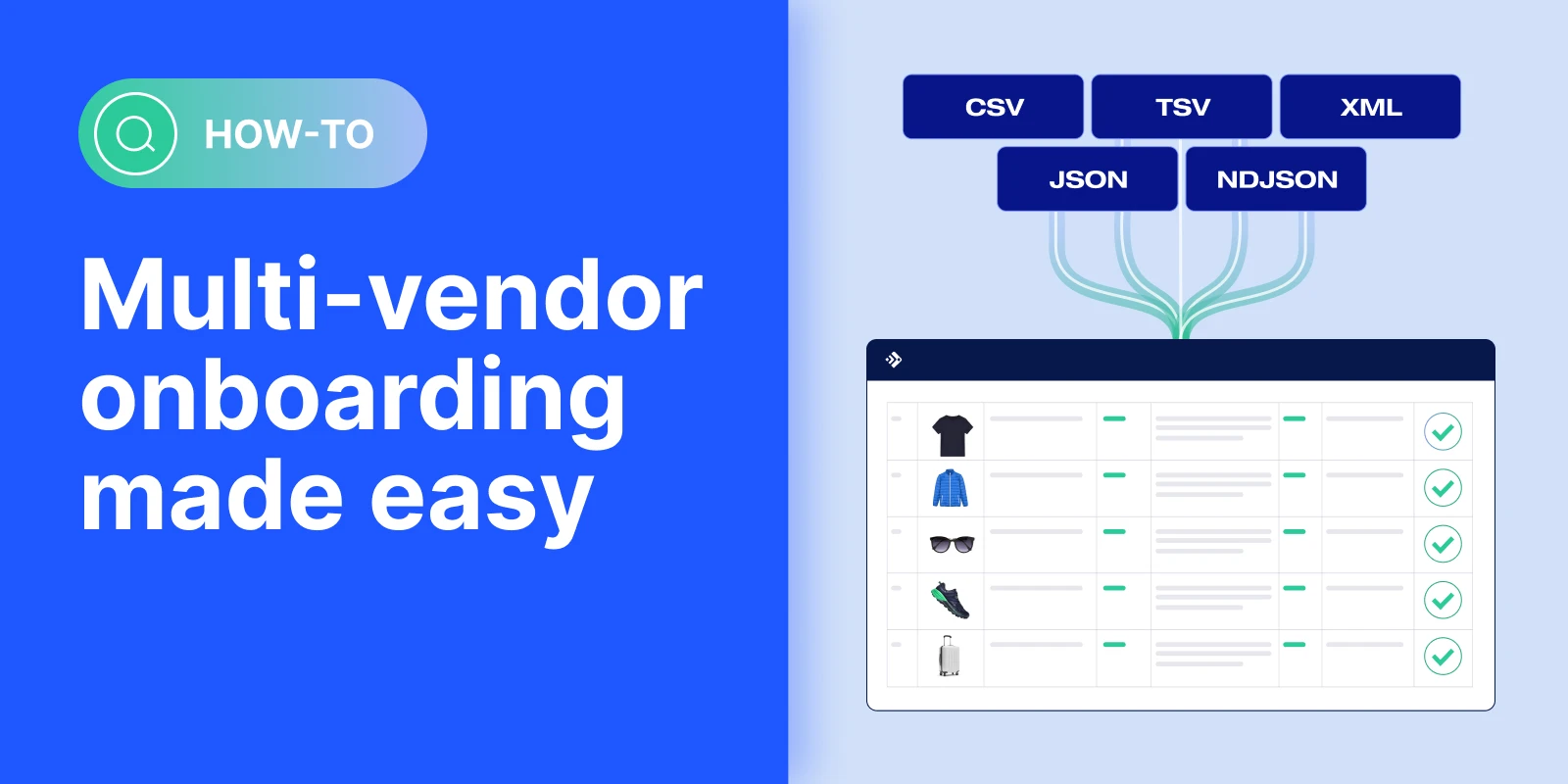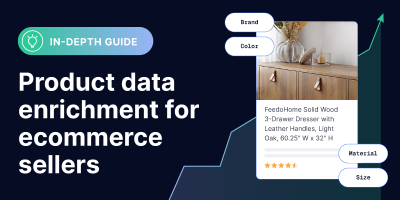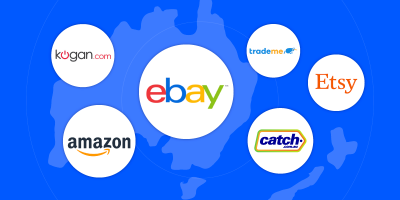For businesses that host custom marketplaces, classifieds platforms, or other sites that depend on third-party listings, the vendor onboarding process is often the first—and most critical—step toward building a thriving catalog of products or services.
Whether you’re onboarding new vendors for a shopping platform, importing job listings from career boards, or aggregating automotive inventories from dealers, the onboarding experience can either accelerate your growth or become a bottleneck that frustrates everyone involved.
Many platforms try to manage vendor onboarding with multiple spreadsheets, manual data entry, and one-off scripts, but these tools quickly become inefficient as new suppliers join the ecosystem. What begins as a simple import can spiral into a time-consuming effort to format, validate, and normalize data for publishing and compliance with internal data standards.
That’s where a feed management platform like Feedonomics comes in. A feed management platform can be used to automate much of the vendor onboarding process—from ingesting and standardizing seller data to enriching listings and distributing them across your marketplace and even external advertising channels.
In this blog, we’ll walk through the common pain points in the vendor onboarding process and explore how to address them with technology that supports procurement and enables scalable, repeatable workflows for long-term success.
Ingesting data from diverse sources efficiently
Before you can standardize or enrich seller data, you first have to ingest it—and that’s often where the complexity begins. New vendors may submit their product data in an array of formats: CSV files, XML feeds, JSON exports, or even unstructured web content. Some provide well-organized datasets pulled from an ERP system, while others may rely on basic spreadsheets. Each source requires careful handling, especially when onboarding hundreds of sellers across different verticals like apparel, automotive, real estate, or job listings.
The traditional vendor onboarding process often involves multiple rounds of data entry, formatting, and validation—either performed manually or through a series of limited scripts. This fragmented approach is difficult to scale and introduces operational inefficiencies that delay time-to-market. It also puts pressure on your team to become technical gatekeepers instead of focusing on higher-value procurement or vendor relationship functions.
And ingesting the data is just the beginning—once listings are live, many vendors require daily or even real-time inventory synchronization to ensure stock levels stay accurate across platforms. Without automated sync, overselling and availability errors can erode trust with customers and sellers alike.
How to ingest data from multiple sources for vendor boarding
A modern feed management platform can simplify this data collection phase by offering flexible ingestion methods:
- Bulk file uploads from SFTP
- Custom APIs that fetch real-time catalog data
- Scheduled web crawls that scrape product content directly from seller websites
- Prebuilt integrations with ecommerce platforms
For example, with Feedonomics, you can collect supplier information from any of these sources and then automatically normalize and consolidate it into a single structured feed.
The right feed management platform will give you a solid foundation for scalable, repeatable onboarding and help reduce your time-to-listing dramatically.
Standardizing product data at scale
Once your platform ingests seller data, the next step is turning that raw information into consistent, listing-ready content. Without proper data validation and formatting, product listings can look disjointed, damaging user trust and degrading the buyer experience.
Most new vendors don’t follow the same formatting rules or naming conventions. Some may include lengthy promotional text in titles, while others may omit required attributes like size, brand, or condition. Left unstandardized, these inconsistencies introduce friction not just for users, but also for backend teams responsible for vendor management, content moderation, or search relevance.
For platforms that manage hundreds of seller catalogs, manual formatting becomes unsustainable. Editing feeds one by one or relying on rigid tools slows down the vendor onboarding process and makes it harder to scale. Worse yet, it delays revenue generation from new suppliers waiting to go live.
How to standardize vendor product data at scale
A robust feed management platform helps automate this transformation process by applying rule-based formatting and validations. Instead of manually editing listings, you can configure logic to perform a wide range of standardization processes:
- Reorder fields in product titles
- Normalize category naming conventions
- Convert measurement units
- Standardize casing, punctuation, and grammar across descriptions
For example, if your formatting standards for automotive listings require that the title starts with the year, followed by the make, model, and trim, then you could create a transformation rule that looks like this:
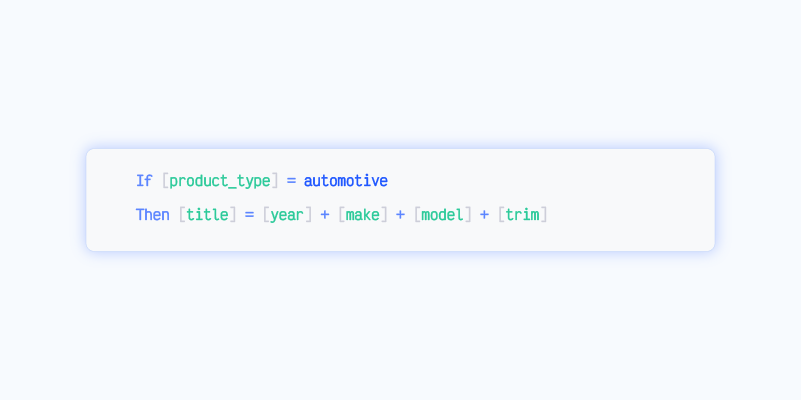
The platform then parses the values from each bracketed attribute and generates uniform automotive titles across the catalog:
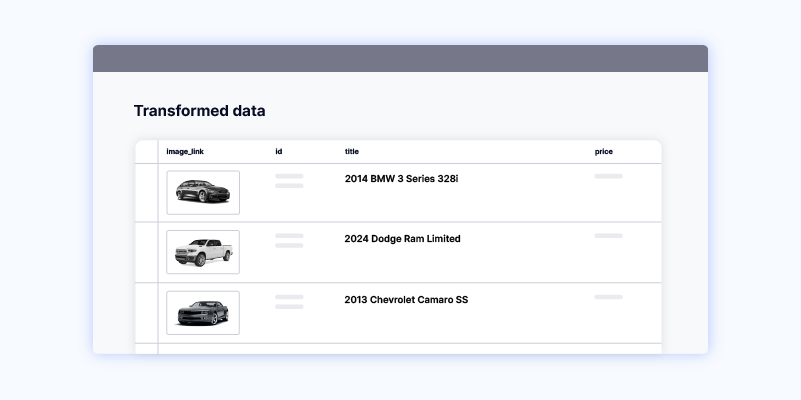
This ensures uniformity across thousands of listings from different sellers, with no manual editing required.
Different seller segments—like real estate agents, apparel retailers, or job boards—can each have their own set of transformation rules, templates, and formatting logic. This compartmentalized approach allows marketplaces to maintain brand consistency without compromising the onboarding experience for new vendors.
With automation replacing manual formatting and data entry, your team gains more time for strategic initiatives. And for the sellers? Faster onboarding means faster time-to-sale and stronger partnerships.
Enriching vendor listings for better visibility and performance
Even with well-formatted data, seller listings can still fall short, especially when they lack compelling product descriptions, strong images, or critical attribute details. Without proper product data enrichment, listings may underperform in search, suffer low conversion rates, or confuse buyers, all of which reflect poorly on your vendor relationships and overall platform reputation.
High-quality listings are essential for optimizing the buyer journey. They help reduce product returns, improve decision-making, and foster trust between customers and new vendors. But enriching thousands—or even millions—of SKUs manually is impossible without automation.
How to optimize vendor listings
With a feed management platform, you can automatically enrich listings at scale:
- Enhancing titles and descriptions using standardized product attributes
- Auto-generating bullet-point features from raw fields (e.g., material, fit, care instructions)
- Inserting missing data fields from cross-referenced databases or seller profiles
- Ensuring consistent imagery and metadata across categories
For example, with Feedonomics, if you have retailers selling clothing on your marketplace, you can set rules within your platform to parse through their product attributes and generate bullet-pointed descriptions that look like this:
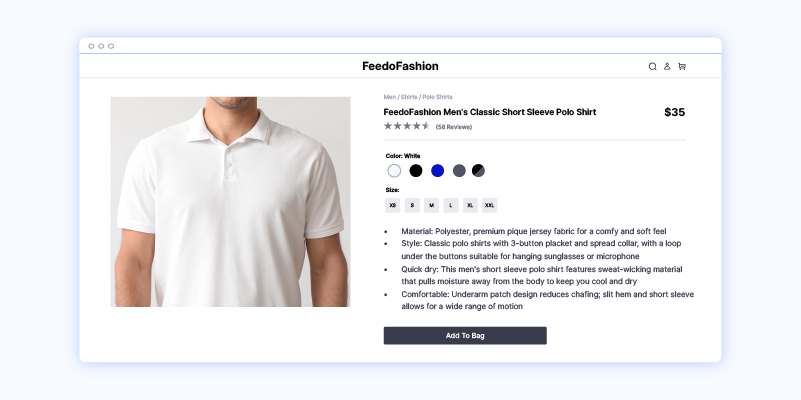
These enriched listings don’t just perform better on your own site; they also meet the data standards of external ad channels and affiliate partners if you decide to list those products elsewhere (more on that in the next section).
Enrichment helps reduce time-to-market, improve vendor performance KPIs, and maximize the ROI of your seller acquisition efforts. And since enrichment is built into the broader vendor onboarding process, there’s no need for additional tools or disruptive handoffs between systems.
Feedonomics offers expert guidance to help sellers and internal teams determine what enrichments matter most for each vertical, elevating product content quality across your entire ecosystem.
Syndicating seller data to drive more traffic
Getting high-quality listings live on your own platform is just one piece of the puzzle. To grow your marketplace, you might need to help sellers reach more buyers off-platform. That means syndicating their data to external channels like Google Shopping, affiliate networks, social commerce sites, and more.
But here’s the challenge: each of these destinations has unique data requirements, formatting rules, and update cadences. Without a centralized system, your team may spend countless hours adjusting feeds manually, or worse, delivering inaccurate or outdated listings that hurt vendor performance and damage vendor relationships.
How to syndicate and synchronize vendor data with multiple channels
For most marketplaces, the technical burden of multi-channel syndication is too great to manage in-house. The solution? A feed management that includes robust export functionality.
Once seller data is ingested, standardized, and enriched, it can be automatically pushed to third-party channels with the correct structure, attributes, and language.
With Feedonomics, behind every successful export, we have a team of channel experts who know exactly how to tailor your data for hundreds of destinations.
This streamlines a traditionally fragmented process and supports your platform’s broader sourcing and marketing efforts by:
- Increasing product visibility across paid media and discovery platforms
- Helping new vendors drive additional sales quickly
- Attracting more sellers by offering built-in distribution advantages
For example, a real estate or auto seller listing on your platform might also want their listings to appear on niche ad networks or syndicated partner sites. With Feedonomics, these exports can be fully automated and governed by the same approval process, formatting rules, and quality checks used on your own marketplace.
By offering end-to-end data distribution, you can strengthen your platform’s competitive advantage and look more appealing to prospective vendors.
Preventing bad data from appearing on your platform
As your platform scales and begins ingesting millions of SKUs from hundreds of new suppliers, maintaining data quality becomes just as important as ingesting and enriching the listings themselves. Without strong data governance safeguards in place, a single misformatted record—or worse, an inaccurate price or inventory count—can confuse customers and erode trust with sellers.
The more sellers you onboard, the more essential robust data governance, validation, and risk management become.
How to implement data governance for your listings
That’s why feed management platforms like Feedonomics incorporate a variety of built-in checks and automation rules designed to catch and correct errors before they go live.
Here are just a few examples of how these safeguards improve the vendor onboarding process:
- Validation rules that ensure critical attributes like title, price, and image URLs are never blank
- Approval processes that stop low-quality or incomplete listings from being published
- Alerts and notifications triggered by missing data or mapping issues
- Inventory buffers that prevent overselling
- Random sampling and spot checks to maintain ongoing vendor performance standards
- Automated retries for failed imports or timed-out exports
- Export conditions that tailor data for specific ad platforms or regulatory requirements
Feedonomics helps reduce downstream issues that could otherwise frustrate buyers or result in vendor risk exposure. This is especially valuable for marketplaces in regulated industries or categories with high consumer scrutiny, such as finance, healthcare, or real estate.
And when problems do arise, Feedonomics’ dedicated support teams act as an extension of your procurement or operations team, helping solve issues quickly.
This type of protection is critical for building long-term trust with your sellers and maintaining healthy vendor relationships. It also gives your internal stakeholders peace of mind, knowing that the system is equipped to catch and correct issues proactively—before they damage your brand or impact your listings.
Scaling seller onboarding with confidence
For any platform that relies on third-party sellers—whether it’s a marketplace, job board, classifieds site, or custom ecommerce hub—the supplier onboarding process is a strategic differentiator that impacts everything from time-to-revenue and catalog quality to supply chain visibility and customer experience.
Manual processes and outdated tools might work for a handful of sellers, but as you scale to hundreds or thousands of new vendors, the cracks start to show. Inconsistent formatting, missing listing information, disorganized vendor data, and slow turnaround times can derail even the most promising partnerships, costing your platform valuable listings, customer trust, and operational agility.
Data feed management platforms like Feedonomics change that.
By automating ingestion, transformation, enrichment, and export, the platform becomes more than an onboarding software tool—it becomes the operational backbone for your vendor management lifecycle. It empowers your procurement team to focus on relationship-building and risk assessment, not manual cleanup. It gives stakeholders the visibility and controls they need to ensure smooth, compliant onboarding. And it gives sellers a better, faster, more scalable path to your marketplace—without requiring them to become data experts.
The result? A streamlined vendor onboarding process that’s faster, more reliable, and scalable.
Eliminate manual work, enforce consistent data standards, and onboard more new suppliers with less friction, so you can scale faster without compromising quality.
Vendor onboarding FAQs
What is the vendor onboarding process in a digital marketplace?
The vendor onboarding process refers to the series of steps a marketplace or ecommerce platform takes to bring new vendors into their ecosystem. This includes collecting and validating supplier data, ingesting product catalogs, standardizing content, and preparing listings for publishing. A streamlined process not only accelerates time-to-market, but also supports stronger supplier relationship management by reducing friction during the initial engagement.
What kind of supplier product data needs to be collected during onboarding?
Typical supplier product data includes product titles, descriptions, pricing, images, inventory levels, and relevant metadata such as brand, color, and condition. In some cases, you’ll also need seller-specific details like payment terms, fulfillment methods, accounts payable contacts, and questionnaire responses for compliance. Platforms like Feedonomics can automatically validate this information during ingestion and flag any missing or misformatted fields.
Why is a vendor onboarding checklist important?
A well-structured vendor onboarding checklist ensures your team collects all the necessary vendor information—such as product categories, pricing structures, brand guidelines, and content formats—from each seller. This helps prevent delays, minimizes back-and-forth communication, and ensures product listings meet your platform’s quality standards from the start.
What role does a vendor portal play in onboarding success?
A vendor portal acts as a centralized hub where sellers can submit and manage their product data, track listing performance, and respond to feedback from your team. When integrated with a feed management platform, this portal can streamline data management, ensure compliance with formatting rules, and reduce the need for manual touchpoints—resulting in a more efficient and transparent onboarding experience for both sellers and internal teams.
How can a questionnaire improve vendor onboarding workflows?
A questionnaire is a useful tool for collecting standardized inputs from vendors (or potential vendors), especially in industries with complex product categories or regulatory requirements. Questions can cover logistics capabilities, payment terms, catalog structures, and listing update frequency. This structured approach ensures sellers provide the necessary information up front, while Feedonomics can help automate the transformation of that data into listing-ready formats.
How do feed management platforms support long-term supplier relationship management?
Feedonomics supports supplier relationship management by reducing onboarding friction, enabling faster go-live timelines, and maintaining high data quality over time. With automated ingestion, validation, and syndication, sellers experience fewer delays and errors, which fosters trust and encourages ongoing collaboration.
How do feed management platforms support supply chain management?
Feed management platforms like Feedonomics play a key role in supply chain management by making seller data ingestion and listing updates faster, more reliable, and scalable. When seller data is inaccurate or incomplete, it can create downstream issues like stockouts, overselling, or fulfillment delays. Automated data pipelines help maintain accurate inventory and product availability across your platform, improving operational stability and customer satisfaction.

Muhammed is a content marketing specialist creating informative content to help ecommerce professionals solve industry challenges and stay ahead of the curve.
